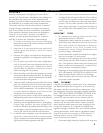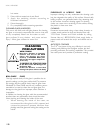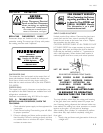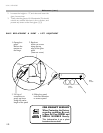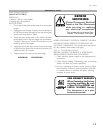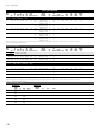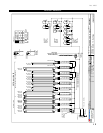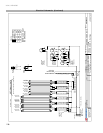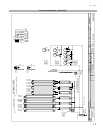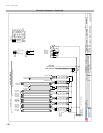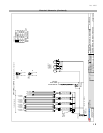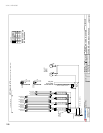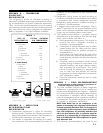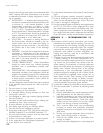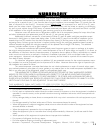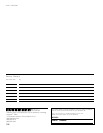VGM, VGD-0505
22
purpose of arriving at easily taken and understood data
which, coupled with other observations, may be used
to determined whether a display refrigerator is work-
ing as intended:
a) INSTRUMENT – A stainless steel stem-type ther-
mometer is recommended and it should have a dial
a minimum of 1 inch internal diameter. A test
thermometer scaled only in Celsius or dually
scaled in Celsius and Fahrenheit shall be accurate
to 1°C (1.8°F). Temperature measuring devices
that are scaled only in Fahrenheit shall be accurate
to 2°F. The thermometer should be checked for
proper calibration. (It should read 32°F when the
stem is immersed in an ice water bath).
b) LOCATION – The probe or sensing element of
the thermometer should be located in the air-
stream where the air first enters the display or
storage area, and not more than 1 inch away from
the surface and in the center of the discharge
opening.
c) READING – It should first be determined that the
refrigerator is refrigerating and has operated at
least one hour since the end of the last defrost
period. The thermometer reading should be made
only after it has been allowed to stabilize, i.e.,
maintain a constant reading.
d) OTHER OBSERVATIONS – Other observations
should be made which may indicate operating
problems, such as unsatisfactory product, feel/
appearance.
e) CONCLUSIONS – In the absence of any apparent
undesirable conditions, the refrigerator should be
judged to be operating properly. If it is determined
that such condition is undesirable, i.e., the product
is above proper temperature, checks should be
made for the following:
1. Has the refrigerator been loaded with warm product?
2. Is the product loaded beyond the “Safe Load Line”
markers?
3. Are the return air ducts blocked?
4. Are the entering air ducts blocked?
5. Is a dumped display causing turbulent air flow and
mixing with room air?
6. Are spotlights or other high intensity lighting directed
onto the product?
7. Are there unusual draft conditions (from heating /air-
conditioning ducts, open doors, etc.)?
8. Is there exposure to direct sunlight?
8. Are display signs blocking or diverting airflow?
9. Are the coils of the refrigerator iced up?
10. Is the store ambient over 75°F, 55% RH as set forth in
ASHRAE Standard 72 and ASHRAE Standard 117?
11. Are the shelf positions, number, and size other than
recommended by Hussmann?
12. Is there an improper application or control system?
13. Is the evaporator fan motor/blade inoperative?
14. Is the defrost time excessive?
15. Is the defrost termination, thermostat (if used) set too
high?
16. Are the refrigerant controls incorrectly adjusted?
17. Is the air entering the condenser above design condi-
tions? Are the condenser fins clear of dirt, dust, etc.?
18. Is there a shortage of refrigerant?
19. Has the equipment been modified to use replacements
for CFC-12, CFC-502 or other refrigerant? If so, have
the modifications been made in accordance with Hus-
smann equipment recommendations? Is the refrigera-
tor charged with the proper refrigerant and lubricant?
Does the system use the recommended compressor?
APPENDIX D. – RECOMMENDATIONS TO
USER -
1.0 Hussmann should provide instructions and recom-
mendations for proper periodic cleaning. The user will
be responsible for such cleaning, including the cleaning
of low temperature equipment within the compart-
ment and the cooling coil area(s). Cleaning practices,
particularly with respect to proper refrigerator un-
loading and warm-up, must be in accordance with
applicable recommendations.
1.1 Cleaning of non frozen food equipment should include
a weekly cleaning of the food compartment as a
minimum to prevent bacteria growth from accumulat-
ing. Actual use and products may dictate more fre-
quent cleaning. Circumstances of use and equipment
design must also dictate the frequency of cleaning the
display areas. Weekly washing down of the storage
compartment is also recommended, especially for
equipment subject to dripping of milk or other liquids,
or the collection of vegetable, meat, crumbs, etc. or
other debris or litter. Daily cleaning of the external
areas surrounding the storage or display compart-
ments with detergent and water will keep the equip-
ment presentable and prevent grime buildup.
1.2 Load levels as defined by Hussmann must be observed.
1.3 The best preservation is achieved by following these
rules:
a) Buy quality products.
b) Receive perishables from transit equipment at the
ideal temperature for the particular product.
c) Expedite perishables to the store’s storage equip-
ment to avoid unnecessary warm-up and pro-
longed temperature recovery. Food store refrig-
erators are not food chillers nor can they reclaim
quality lost through previous mishandling.
d) Care must be taken when cross merchandising
products to ensure that potentially hazardous
vegetable products are not placed in non refriger-
ated areas.
e) Display and storage equipment doors should be
kept closed during periods of inactivity.
f) Minimize the transfer time of perishables from
storage to display.
g) Keep meat under refrigeration in meat cutting and



